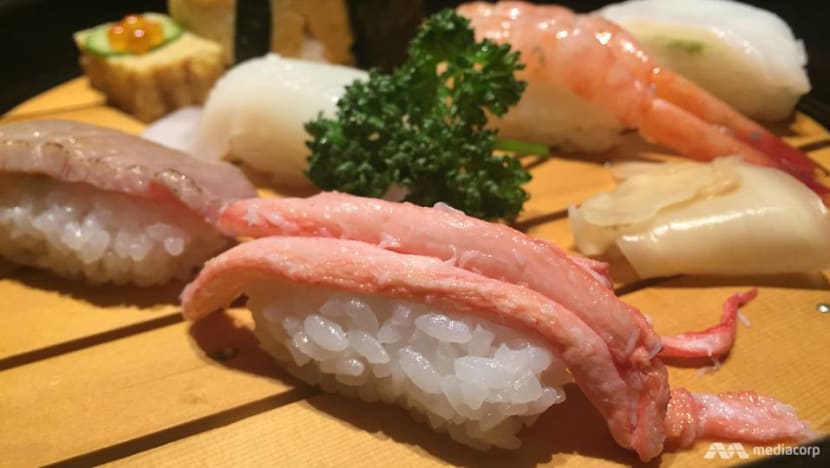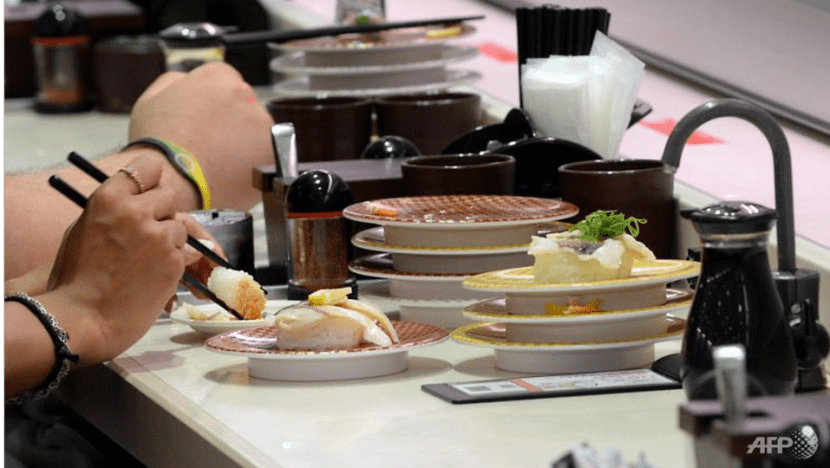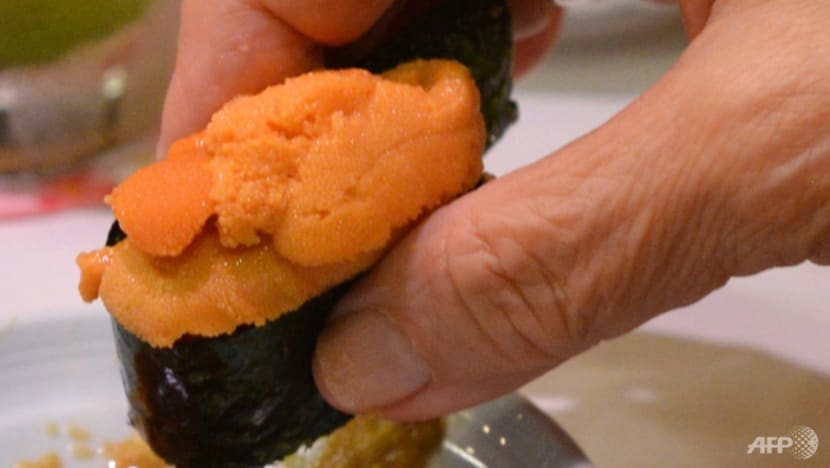How safe is your sashimi and sushi?
Singapore’s food authority has stringent requirements for importing raw seafood, while suppliers and supermarkets here tell Channel NewsAsia how they keep such products clean - and free of parasites which have been on the rise in Japan.

File photo of sushi. (Photo: Diane Leow)
SINGAPORE: Stringent standards and checks are in place to lower the risks from consuming sashimi and sushi, and consumers should only buy such products from credible sources, advised Singapore-based suppliers and supermarkets selling raw seafood products.
Earlier in May, Japanese and Western authorities issued warnings about the rising number of infections by the parasitic Anisakis worm, caused by eating raw seafood. In response to queries from Channel NewsAsia, Singapore’s Ministry of Health noted that there are risks involved in consuming raw fish as “harmful bacteria, viruses and parasites may be present”.
“Vulnerable groups, such as young children, pregnant women, elderly persons, or those with chronic illnesses such as diabetes, should exercise caution by avoiding the consumption of raw fish,” said a spokesperson.
This was echoed by the Agri-Food & Veterinary Authority (AVA), which emphasised that ready-to-eat (RTE) raw fish is considered a “high-risk” food due to the lack of heat treatment to destroy microbial pathogens and parasites, and that cooking raw food thoroughly is still the most effective way to kill them.
For uncooked fish, however, preventive measures to kill parasitic larvae include deep freezing at temperatures ranging from minus 35 to minus 20 degrees, according to various countries’ administrations.
Singapore grocer and restaurant Fish Mart Sakuraya follows the guidelines of the Japanese Ministry of Health, Labour and Welfare, said assistant general manager Maeda Yujiro.
“For avoiding the risk of parasitic worms, some types of fish such as salmon are kept frozen in less than minus 20 degrees Celsius for 24 hours before sale.”
SUPPLY STREAM
In general, fish can be imported into Singapore from any country, subject to AVA’s import requirements, surveillance, inspection and sampling programme, said a spokesperson for the agency.
Noting that the risk of Anisakis in wild-caught seafood was not dependent on the source country, AVA outlined its “more stringent” requirements for RTE raw fish: “Imports are subject to a higher frequency of inspection and ‘hold-and-test’ sampling, which means that the consignment is only released for sale upon successful completion of laboratory tests.”
Said the spokesperson. “These tests include chemical contaminants (e.g. drug residues), microbial pathogens (e.g. E. coli) and presence of parasites (e.g. Anisakis). Consignments that fail our inspection or tests are not allowed to be sold.”
Amanda Tan, founder of Japanese online supplier Zairyo, said AVA officials are usually on hand to double-check food products arriving in Singapore.
“If it doesn’t pass AVA, we won’t be able to get it,” she said.
Most of Zairyo’s products are purchased directly from the famed Tsukiji Market in Tokyo, Japan, where the seafood is flash-frozen before being immediately flown over, Ms Tan explained.
“The process kills the bacteria but maintains the quality,” she said. “We do bring in fresh seafood, which is chilled but not frozen, in which case we apply even more stringent checks.”
“Unlike supermarkets, we don’t fly products in and keep them on the shelf. We order from Japan only when someone orders it, so it’s as fresh as it gets.”
A spokesperson for iMei, a supplier of Japanese food and beverage products to Singapore supermarkets, restaurants and hotels, said the company rejects items which arrive not fresh or at the wrong temperature.
“Our fresh items only come twice a week by air so we don’t keep any stock in our warehouse,” he added.

STRICT STANDARDS
AVA said it works with the National Environment Agency (NEA) to jointly evaluate applications from food retail establishments required to obtain permission to sell RTE raw fish dishes using saltwater fish.
“These include assessing that the raw fish is imported and obtained from approved sources and is handled hygienically, and that proper cold chain management is implemented through the supply chain,” it added.
“Both the retailers’ and suppliers’ premises will also be inspected to ensure that they comply with the necessary hygiene requirements for separate processing, handling and storage of RTE raw fish from other raw foods intended for cooking.”
Aside from sourcing its sushi sold at ready-to-eat counters from AVA-licensed suppliers, the NTUC Fairprice supermarket chain conducts independent tests periodically to ensure such products are free from pathogens, said a spokesperson.
FairPrice has an “extensive” food safety and quality assurance programme in compliance with the ISO 22000:2005 international standard, which is more stringent than current standards required by local authorities, she added.
“Food safety and quality are of paramount concern for us,” said the spokesperson. “And we also have a system of stringent checks and audits on a regular basis to ensure the safety of food products that go out to consumers.”
Fish Mart Sakuraya imports most of its raw fish from a Japanese source, said Mr Yujiro.
Their safety standards for sushi and sashimi include ensuring cleanliness of food, instruments, kitchen and people; as well as swift processing of food to prevent germ growth.
“Our chefs check the freshness of fish one by one, and process them - wash, unscale and take out guts and gills - before keeping them in the chiller or freezer quickly,” said Mr Yujiro.
“All outlets’ chiller and freezer temperatures are strictly kept on a standard and checked twice a day,” he noted. “Raw fish products are checked again when they are sliced and prepared as sashimi or sushi, before being served to the customer.”

RANDOM CHECKS
RE&S, a company behind Japanese restaurants such as Ichiban Boshi and Kuishin Bo as well as the Kuriya Market, said that all its outlets serve farm-bred Norwegian salmon, which is certified by the National Institute of Nutrition and Seafood Research to be “unconditionally fit for consumption in a raw, semi-raw or smoked state”.
A spokesperson detailed the process of preparation for its RTE raw fish products, explaining: “Salmon received at our central kitchen is supported by a Certificate of Analysis and goes through a stringent check list upon arrival, with microbial analysis conducted on every batch.”
“The whole salmon is then cut and filleted at our central kitchen which is fully ISO 22,000 certified and fitted with air shower sanitising zones and have a fully controlled internal environment to ensure the highest levels of food safety and hygiene.”
She added: “At the outlets, we work with an external NEA-approved laboratory to conduct checks on bacteria count of selected sushi, sashimi and cooked food products. These checks are regularly conducted.”
“To ensure the integrity of these tests, the list of items to be collected and checked as well as the date and time for the collection of test samples are unknown to outlets. On top of that, NEA also conducts unannounced random checks at outlets by purchasing the food and testing for pathogens in accredited laboratories.”

COMMON SENSE
The FairPrice spokesperson’s advice to customers was to either consume ready-to-eat raw seafood immediately upon purchase, or store in an insulated bag for transport home before consuming within two hours. If needed, FairPrice supermarkets can provide ice packs for customers.
“For sashimi, I don’t recommend keeping it for more than two days once you receive it,” said Ms Tan.
As for eating in restaurants, the iMei spokesperson offered: “For fresh items, please see the colour - if it is bright, it is fresh. If it’s dark, we advise not to eat or buy.”
Ultimately, raw fish is safe to be consumed when it is processed and handled in a proper way, Mr Yujiro stressed. “It is important to buy and eat sushi and sashimi from a reliable shop with knowledge and experience for every type of fish they sell.”
“Always buy your sushi and sashimi from established, safe, reliable sources,” said the RE&S spokesperson.
“This is not the first time people are freaking out over this sort of news,” said Ms Tan. “Buy from a credible source. Don’t go to a cheap restaurant to eat sushi or sashimi. If you do, then you’re running a higher risk.”














